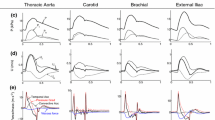Abstract
An analytical iterative scheme is presented for computing the local characteristics of pressure and flow waves as they progress along a tree structure and become modified by wave reflections. Results are obtained to illustrate the phenoenon of pressure peaking under two different sets of circumstances. In the first case, the propagation of a single harmonic wave along a simple tree is considered, where wave reflections modify the amplitude of the pressure wave as it travels. In the second case, the propagation of a composite wave along a tree with multiple branches is considered, where wave reflections modify the shape of the wave as it travels and cause it to peak. The results demonstrate unambiguously that the root cause of this phenomenon is wave reflections caused by stepwise decreases in admittance, as has been previously suggested, rather than due to nonlinear interactions, as has also been previously suggested. It is shown clearly that even when wave reflections combine linearly, they lead to considerable peaking in the pressure waveform.
Similar content being viewed by others
References
Avolio, A. P. Multi-branched model of the human arterial system.Med. Biol. Eng. Comput. 18:709–718, 1980.
Barnard, A. C. L., W. A. Hunt, W. P. Timlake, and E. Varley. Peaking of pressure pulse in fluid-filled tubes of spatially varying compliance.Biophys. J. 6:735–746, 1966.
Duan, B., and M. Zamir (1992) Viscous damping in one dimensional wave transmission.J. Acoust. Soc. Am. 92: 3358–3363, 1992.
Fung, Y. C.Biodynamics: Circulation. New York: Springer-Verlag, 1984.
Helal, M. A., K. C. Watts, A. E. Marble, and S. N. Sarwal. Theoretical model for assessing haemodynamics in arterial networks which include bypass grafts.Med. Biol. Eng. Comput. 28:465–473, 1990.
Karreman, G. Some contributions to the mathematical biology of blood circulation. Reflection of pressure waves in the arterial system.Bull. Math. Biophys. 14:327–350, 1952.
Kouchoukos, N. T., L. C. Sheppard, and D. A. McDonald. Estimation of stroke volume in the dog by a pulse contour method.Circ. Res. 26:611–23, 1970.
Lighthill, M.Mathematical Biofluiddynamics. Philadelphia: Society for Industrial & Applied Mathematics, 1975.
McDonald, D. A.Blood Flow in Arteries. Baltimore: Williams & Wilkins, 1974.
Milnor, W. R.Hemodynamics. Baltimore: Williams & Wilkins, 1989, 419 pp.
Singhal, S., R. Henderson, K. Horsfield, K. Harding, and G. Cumming. Morphometry of the human pulmonary arterial tree.Circ. Res. 33:190–197, 1973.
Strahler, A. N. Revisions of Horton's quantitative factors in erosional terrain.Trans. Am. Geophys. Union 34:345, 1953.
Strahler, A. N. Quantitative analysis of watershed geomorphology.Trans. Am. Geophys. Union 38:913–920, 1957.
Taylor, M. G. An approach to an analysis of the arterial pulse wave 1. Oscillations in an attenuating line.Phys. Med. Biol. 1:258–269, 1957.
Taylor, M. G. An approach to an analysis of the arterial pulse wave II. Fluid oscillations in an elastic pipe.Phys. Med. Biol. 1:321–329, 1957.
Taylor, M. G. The input impedance of an assembly of randomly branching elastic tubes.Biophys. J. 6:29–51, 1966.
Taylor, M. G. Wave transmission through an assembly of randomly branching elastic tubes.Biophys. J. 6:697–716, 1966.
Weibel, E. R.Morphometry of the Human Lung. Berlin: Springer-Verlag, 1963, 151 pp.
Westerhof, N., and A. Noordergraaf. Arterial viscoelasticity: a generalized model-effect on input impedance and wave travel in the systematic tree.J. Biomech. 3:357–379, 1970.
Zamir, M. Optimality principles in arterial branching.J. Theor. Biol. 62:227–251, 1976.
Zamir, M. The branching structure of arterial trees.Comments Theor. Biol. 1:15–37, 1988.
Zamir, M., and S. Phipps. Network analysis of an arterial tree.J. Biomech. 21:25–34, 1988.
Zamir, M., P. Sinclair, and T. H. Wonnacott. Relation between diameter and flow rate in blood vessels.J. Biomech. 25:1303–1310, 1992.
Author information
Authors and Affiliations
Rights and permissions
About this article
Cite this article
Duan, B., Zamir, M. Pressure peaking in pulsatile flow through arterial tree structures. Ann Biomed Eng 23, 794–803 (1995). https://doi.org/10.1007/BF02584478
Received:
Revised:
Accepted:
Issue Date:
DOI: https://doi.org/10.1007/BF02584478




